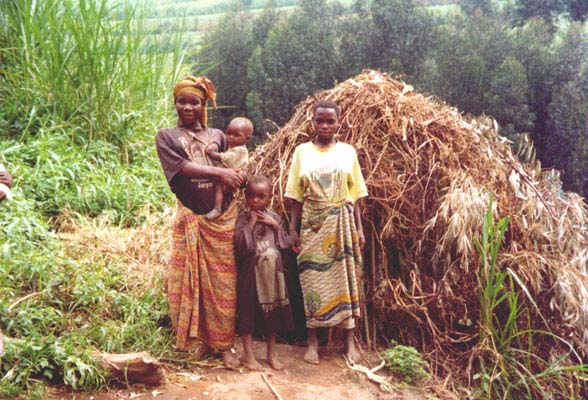Rwanda - History Essay

Rwanda is a small country located in central Africa. With a total of 9,633 square miles this country has seen a great deal of conflict between ethnic groups, causing this country to be known for the genocide that has occurred. The earliest colonist of Rwanda was the Twa, later joined by the Hutu and then the Tutsi. The ethnic differences between the Hutu and the Tutsi are what sparked the genocide. In this paper I will discuss the early inhabits of this country, what led to such a destructive genocide and the outcome that brought the country to where it is today.
Starting
with the pre-colonial era, the Twa originally inhabited Rwanda. They were
considered Pygmy people and sustained life by hunting and gathering. The Hutus
soon arrived in Rwanda, out populating the Twa . The Hutu were short and square,
they were regarded as agricultural people and began clearing the forests of
Rwanda for their permanent settlements. The Tutsis then migrated into the area
around the 14th century dominating over both Twa and Hutu. The Tutsi
were opposite compared to the Hutu and Twa, they were tall, thin, and raised
cattle. Although the Hutu and Tutsi are two separate ethnic groups they are
sometimes hard to distinguish for the reason that they speak the same language,
often have intermarriages and share similar cultural characteristics.
Unfortunately their distinctive differences led to the killing of over one
million people.
The
Tutsi and Hutu had categorized themselves into small states but the Tutsi
created a hierarchy led by a king, or also known as “Mwami”. The king was in
control of hundreds of estates. Most people under Mwami were also Tutsi, very
few were Hutu. During this time it is believed that Hutu and Tutsi were on good
terms with one another.
During
the colonial era European explores first visited Rwanda in 1854. In 1890 they
accepted German overrule and became part of the German East Africa. It was not
until 1907 when a German administrative officer was assigned to Rwanda but the
Germans did not have a voice in the counties affairs. They also did not try to
commence any economic development. Belgian troops occupied Rwanda during World
War 1 and in 1916, after the war, it became a Belgian League of Nations mandate
of Ruanda-Urundi.
The
Belgians favored the Tutsi for their larger skulls, larger size, and skin
color. For these characteristics they thought the Tutsi were from Caucasian
ancestry, thus they were superior to Hutus and therefore were given more power.
The Tutsi started to believe the Belgians, they began to think of them selves
as superior and were not afraid to show it. In 1931 ethnic identity cards were
mandated. The Hutus began to see the truth behind the ethnic identity cards and
realized that a change needed to be made. They slowly gained respect from the
Belgium’s and were given secret ballots in the electoral process. The Catholic
Church also began to see the mistreatment that the Tutsi placed upon the Hutus
and began encouraging equality. Tutsis were in jeopardy of losing their position
of the rulers.
In
1954 Charles made drastic changes to provide equality. The land was distributed
between the Hutu and Tutsi, leaving the Tutsi very aggravated and led to the
assassination Charles in 1959. The Tutsi lost their power completely when King
Kigeri V fled to Uganda. Then the angry Tutsi attempted to kill Gregoire
Kayibanda, the leader of the Hutu political party. This caused the beginning of
the genocide with an estimated amount of 20,000 to 100,000 Tutsis killed by Hutus.
Rwanda
became independent in 1962 under the power of the Hutu. The Tutsis that were
not exiled to neighboring countries were barred from having any political
power. The new Rwanda was made up of Hutus and Catholics. The remaining Tutsis
were given quotas, allowing only 10% to go to school and work. In 1964 another
system of inequality was implemented, Hutu could murder Tutsi and not be
prosecuted. This caused more Tutsi to flee to surrounding countries. Life for
Tutsi continued to get worse; they were forced out of their jobs and ultimately
put into exile.
An
airplane carrying the president of Rwanda and Burundi was shot down on April 6,
1994, killing both presidents. After this incident the military and militia groups
began capturing and murdering the Tutsi population. In 100 days around 800,000
Tutsi were killed. The Tutsi acted back, bringing in the Rwandan Patriotic
Front creating a 14-week civil war. The Civil War ended in July 1994 with the
Tutsi victorious, causing 1.7 million Hutu to flee into neighboring country
Zaire.
The
tables have turned for Rwanda and they are trying to gain unity among each
other. In order to see peace prosper, the government has implemented a National
Unity and Reconciliation Commission to oversea reconciliation process. In May
2003, 93% of Rwandans voted in favor new constitution that instituted a balance
of political power between Hutu and Tutsi. This will keep seats in parliament
equal and minimize ethnic hatred. Rwanda is heading into the future with hopes
of equality among ethnic groups.